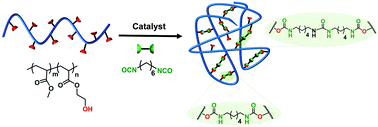Advantages and limitations of diisocyanates in intramolecular collapse†
Abstract
A comprehensive examination of the synthesis of single chain polymer nanoparticles (SCPNs) from a copolymer of methyl acrylate (MA) and 2-hydroxyethyl acrylate (HEA) via the intra-chain urethane formation by using hexamethylene diisocyanate (HDI) as a cross-linker is described. By introducing model urethane, urea, and amine compounds, the resulting SCPNs were carefully characterized by NMR, DSC, IR and GPC. In addition to the advantages of using cheap and accessible commercially available materials, the effects of the long reaction time under high dilution or harsher heating conditions on the cross-linking chemistry are studied, providing clear limitations on the use of this chemistry for intra-chain collapse.



 Please wait while we load your content...
Please wait while we load your content...